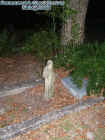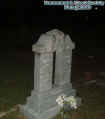|
|
||
|
In 1880 Progar and Adelaide Deborgary donated the land in Geneva FL for a cemetery which would be used as a small community cemetery. Progor Debogory was the head of one the Russian families who settled in Geneva in the later 1800's. Besides donating a cemetery he donated a church and school for the local residents. Many people referred to him as a nobleman. The cemetery today is in extremely good condition considering its age perhaps cause it sits nestled back on a dirt road in the woods. Many of the burials here are younger ladies in there late teens which I found to be a little unusual. Its just not something you see all the time when browsing a historical graveyard. At one time on the cemetery property was a church called the Lake Harney Baptist Church which was built in 1880 at the west end of the cemetery and a one room log school house near by. In 1952 the Geneva Historical Society and Genealogical society were formed. They had a goal to put a fence around the cemetery. The reason for this is around WWII the area was very popular for fox hunting so the fox hunters would ride right through the cemetery toppling headstones. The Societies asked them to stop but it continued hence the fence around it. Many of the monuments or burials are prominent people from Geneva's history which are also in displays at the local museum. Geneva was a very small settlement at one time sort of a creepy type of town with old pioneer churches and little houses off into the woods. But Geneva was home to the Seminole Indians, A Lumber Company, and a railroad station where a packing plant use to ship of goods by train. So alot of little history all packed into one cemetery really makes a wonderful ghost tour indeed. The cemetery is haunted by a presence which is very shy perhaps. But its not a presence that is very active but I did notice on our first investigation it followed me out of the cemetery and to the car. So its a friendly little cemetery in my opinion with alot of warm feelings. Also there is 15 confederate soldiers from the civil war buried here and 2 Union Soldiers. If you read a little further below you can read about a conspiracy that took place with Lincoln and a guest buried in Geneva Cemetery. © By Rick-LordOfThyNight
"Geneva and the Lincoln Conspiracy"
Lewis Thornton Powell Lewis Thornton Powell was born in Randolph County, Alabama on 22 April 1844 to George Cader and Patience Caroline Powell. He was the eighth surviving child and youngest boy in a family of 10 children. His father was a Baptist minister, schoolteacher, and farmer. Lewis was a quiet introverted youth that enjoyed reading. He was an animal lover that enjoyed taking care of sick and stray animals, which earned him the nickname "Doc". The Powell family later moved to Stewart and Worth County, Georgia and eventually settled near the small town of Live Oak from where he joined the Confederate Army on 30 May 1861. Lewis Thornton Powell's Civil War Career In 1863 Lewis participated in the Battle of Gettysburg, suffered a gunshot wound to his right wrist, was captured and then sent to the Union Field Hospital in Gettysburg. He was later transferred to Letterman General Hospital and then to the U.S. General Hospital in Baltimore, Maryland. Since his wounds were not serious, Lewis assisted the nurses in taking care of the other patients. On 7 Sep 1863, 5 days after arriving in Baltimore, he escaped from the Union hospital. Lewis headed to Virginia, hoping to reunite with his unit. On the way he ran into a Union camp, introduced himself as Lewis Paine, convinced them he was a civilian trying to make his way home and went on his way. Unable to reunite with his old unit, he managed to join the famous Mosby’s Rangers, which had been mustered into Confederate service in Virginia on 10 Jun 1863. Lewis Powell, alias Paine, rode with Mosby’s Rangers until January of 1865 at which time he left the unit. He worked his way through Union lines near Alexander, VA and made his way to Baltimore and the boarding house owned by the family of Miss Margaret Branson whom he had met while in the Union hospital at Gettysburg. While in Baltimore he met Confederate Operatives (Secret Service), one of which was John Harrison Surratt, Jr. Surratt was serving as a courier for the Confederate Secretary of War, who through his connections, arranged for Lewis to be introduced to John Wilkes Booth. Lewis Powell then went to Washington and boarded at the home of Mrs. Mary Surratt, the mother of John Surratt. It was at this boarding house the plans for kidnapping President Lincoln materialized. The idea was to kidnap Lincoln and use him as ransom to obtain the release of Confederate soldiers that were being held prisoner. The opportunity to pull off the kidnapping never presented itself and was abandoned in March of 1865 and the plan for assassinations was put into operation instead. Lewis Powell was given the assignment to assassinate Secretary of State William Seward who was at his home recovering from a carriage accident. On the night of 14 Apr 1865 Lewis Powell, along with David Herold, rode to Seward’s house. Lewis pretended to be delivering medicine for Seward and was allowed to enter the home. He headed upstairs to Seward’s bedroom but was stopped by Seward's son at the top of the stairs. Lewis tried to shoot the son in the head but his gun misfired. Using his gun as a club, he beat Seward’s son to the floor. Lewis then pulled his knife, crashed through the bedroom door and proceeded to stab Secretary Seward and others that came to his aid. Lewis escaped, stabbing others as he fled down the stairs. Once outside the house, Lewis found that Herold had run away leaving Lewis’s horse tied to a tree. He calmly mounted his horse and rode away into the night. He spent 3 days in the woods and then worked his way back to Mary Surratt’s boarding house where detectives took him into custody. Mary Surratt was also taken into custody for hiding the fugitives. By 28 Apr 1865, 15 days after the assassination, the authorities had 8 conspirators to prosecute. The trial began on 9 May 1865 and lasted for almost 2 months. On 28 Jun the decision was made to hang four of the conspirators, George Atzerodt, David Herold, Mary Surratt and Lewis Powell. For information on the trial see The Lincoln Conspirator's - 1865. Lewis Thornton Powell and the other three were hanged on 7 Jul 1865. His body was buried in the penitentiary courtyard near the gallows where he was hanged, was re-interred several times in the years following his hanging and the location of his body is now unknown. In January of 1992, the tagged skull of Lewis Thornton Powell was discovered in the Smithsonian Anthropology Department among mostly Indian remains that were being identified for return to their appropriate tribes. The Smithsonian began to search for the nearest living relative of Lewis and their search led them to relatives in Geneva, Florida. On November 12, 1994, in the Geneva Cemetery, a dignified ceremony was held and the the skull of Lewis Thornton Powell was interred in a small, velvet-lined, mahogany casket near the grave of his mother, Patience Caroline Powell. Sometime in 1867 Powell's family moved to Orange County and settled near Lake Jessup. Reverend George Cader Powell, his father, founded the First Baptist Church of Apopka and also became the first pastor of the First Baptist Church of Geneva. Reverend and Mrs. Powell’s daughters married into prominent families in the area.
|
||
|
|
|
















